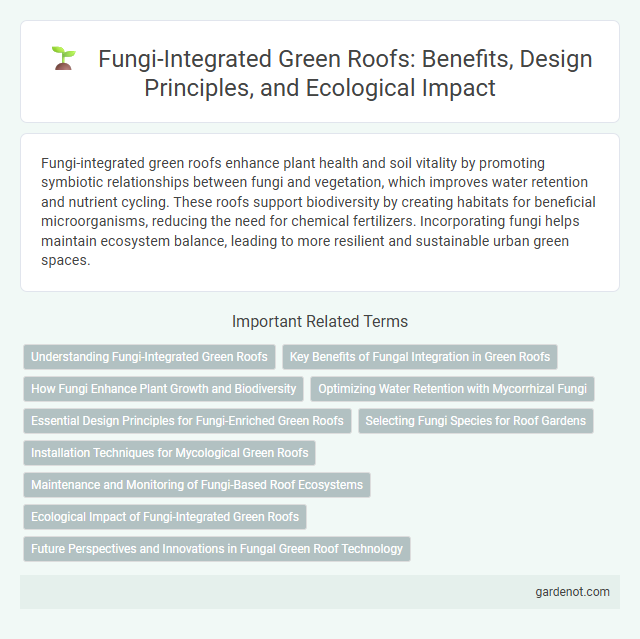Fungi-integrated green roofs enhance plant health and soil vitality by promoting symbiotic relationships between fungi and vegetation, which improves water retention and nutrient cycling. These roofs support biodiversity by creating habitats for beneficial microorganisms, reducing the need for chemical fertilizers. Incorporating fungi helps maintain ecosystem balance, leading to more resilient and sustainable urban green spaces.
Understanding Fungi-Integrated Green Roofs
Fungi-integrated green roofs incorporate mycorrhizal fungi to enhance plant root systems, improve nutrient absorption, and increase soil health, leading to more resilient vegetation and better stormwater management. These specialized fungi form symbiotic relationships with plant roots, facilitating water retention and decomposition of organic matter, which supports sustainable ecosystems atop urban structures. Integrating fungi into green roofs promotes biodiversity and mitigates environmental stressors like heavy rainfall and heat, optimizing green roof performance and longevity.
Key Benefits of Fungal Integration in Green Roofs
Fungi-integrated green roofs enhance plant health by improving nutrient cycling and water retention through mycorrhizal networks. These fungal associations increase soil structure stability and boost resistance to drought and environmental stress. Incorporating fungi also supports biodiversity, promoting a balanced micro-ecosystem that enhances overall green roof sustainability.
How Fungi Enhance Plant Growth and Biodiversity
Fungi-integrated green roofs significantly enhance plant growth by forming symbiotic mycorrhizal associations that improve nutrient uptake, especially phosphorus and nitrogen. These fungal networks increase soil health and moisture retention, promoting robust root systems and increased plant resilience against environmental stressors. Enhanced biodiversity results from fungi supporting diverse microbial communities and facilitating the establishment of various plant species, thereby creating a more balanced and sustainable green roof ecosystem.
Optimizing Water Retention with Mycorrhizal Fungi
Mycorrhizal fungi enhance water retention in green roofs by forming symbiotic relationships with plant roots, improving soil structure and moisture absorption capacity. These fungi increase the surface area for water uptake and create hyphal networks that distribute water efficiently throughout the substrate. Integrating mycorrhizal fungi into green roof systems reduces irrigation needs and promotes plant resilience during drought conditions.
Essential Design Principles for Fungi-Enriched Green Roofs
Fungi-integrated green roofs enhance plant health and soil stability by incorporating mycorrhizal fungi that promote nutrient exchange and water retention. Key design principles include selecting fungal species compatible with local vegetation, maintaining appropriate substrate conditions such as pH and moisture levels, and ensuring sufficient organic matter to support fungal growth. Proper integration optimizes ecosystem services, improves roof longevity, and supports biodiversity in urban environments.
Selecting Fungi Species for Roof Gardens
Selecting fungi species for fungi-integrated green roofs involves prioritizing those with strong symbiotic relationships like mycorrhizal fungi, which enhance plant nutrient uptake and stress tolerance. Species such as Trichoderma and Glomus are commonly chosen for their ability to improve soil structure, retain moisture, and suppress pathogens. Careful consideration of environmental conditions and plant compatibility is essential to maximize the ecological and functional benefits of fungi in roof garden ecosystems.
Installation Techniques for Mycological Green Roofs
Fungi-integrated green roofs require precise installation techniques involving layering a specialized mycelium-infused substrate that enhances nutrient cycling and water retention. Incorporating fungal inoculants directly into growing mediums or using pre-colonized mycelium mats promotes symbiotic relationships with plant roots, improving resilience and growth. Proper environmental control, including moisture levels and aeration, is essential during installation to support mycelial development and ensure long-term roof ecosystem stability.
Maintenance and Monitoring of Fungi-Based Roof Ecosystems
Fungi-integrated green roofs require regular maintenance including moisture level monitoring and fungal health assessments to support mycelium growth and enhance nutrient cycling. Soil pH and organic matter content must be periodically tested to ensure optimal conditions for symbiotic fungal communities. Maintenance protocols focus on preventing fungal diseases and managing invasive species while tracking ecosystem stability through microbial diversity analysis.
Ecological Impact of Fungi-Integrated Green Roofs
Fungi-integrated green roofs enhance urban biodiversity by promoting symbiotic relationships between mycorrhizal fungi and plant roots, which improve nutrient cycling and soil health. These fungi contribute to increased plant resilience against drought and pollutants, supporting a more robust and sustainable green roof ecosystem. Their presence also aids in carbon sequestration, making fungi-integrated green roofs an effective strategy for mitigating urban heat island effects and enhancing ecological sustainability.
Future Perspectives and Innovations in Fungal Green Roof Technology
Fungi-integrated green roofs represent a cutting-edge innovation in sustainable urban architecture, enhancing plant nutrient absorption and soil health through mycorrhizal symbiosis. Future developments emphasize genetic engineering of fungal strains to optimize drought resistance and pollutant degradation, significantly improving the ecological efficiency of green roofs. Advances in biotechnology and sensor integration enable real-time monitoring and adaptive management, transforming fungal green roofs into smart ecosystems that support urban biodiversity and climate resilience.
Fungi-integrated green roof Infographic

 gardenot.com
gardenot.com